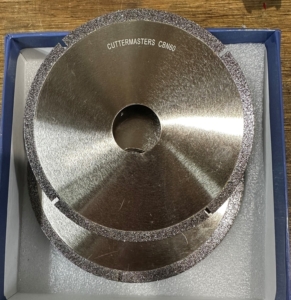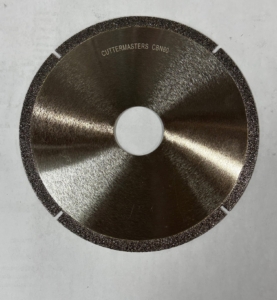Fast Cut CBN cut off wheels 60 Grit for Cutting Hardened Steel and HSS on a Tradesman Machinist


CBN Was Invented by General Electric as a superabrasive to be used on carbon steels.
Diamond, Steel, and heat do not get along
DIAMOND GRINDING WHEELS, THEY’RE NOT MEANT TO USE FOR STEEL
Blog | December 4th, 2018 great article .
Just as a warning to the wise, diamond grinding wheels are not designed to abrade or cut steel. There are other tools for this job. Remember, diamonds are made of highly cohesive arrays of carbon atoms. Remember, also, steel uses carbon as a strengthening element. Steel, in actual fact, is an iron-carbon alloy, which also adds chromium and several other exotic metals to the mix. Diamonds and steel don’t mix.
Complex Microcrystalline Structures
Yes, steel has a complex grain structure. It forms into austenitic materials, martensitic alloys, and a handful of super-toughened alloys. Unlike hard stone, glass and tile, those tightly packed grains are incredibly rigid and next to impossible to break. Needless to say, a super-abrasive grinding wheel can still polish or add a finish to steel, but the process is hard to control, so other grinding solutions are sought out instead. Steel is also heat treated and imbued with carbon-reinforced strength. Again, diamonds, as mentioned above, are another form of carbon, albeit a more attractive and desirable form.
Abrasion-Resisting Frictional Constraints
When diamond grinding wheels and steel clash, massive amounts of thermal energy are released. The heat loosens the diamond bonding agent and sends clouds of synthetic crystals flying. Coated in nickel, the wheel erodes. It’s almost as if the steel surface affects its own abrasive influence, with the grain and diffused carbon cutting into the spinning wheel. Meanwhile, the thermal energy soaks the wheel, so the bonding material breaks down a little more. And, just when the frictional effect is really impacting this expensive tool, the heat is also soaking into the steel workpiece. Worryingly, the grain undergoes a transformative phase when the temperature of the spinning diamonds rises. All signs point the same way, so a substitute super-abrasive material should really be recruited instead of a diamond grinding wheel. Leave diamonds for tile cutting, for granite and quartz and glass, not for carbon-strengthened steel.
All else aside, diamond grinding wheels are expensive. Unlike a cheap drill bit, we can’t just assume a give-it-a-go attitude and hope for the best. And that’s an approach that applies doubly so to steel, an intergranular, hardened alloy that uses diffused carbon. Diamond binding agents wear down fast when they’re used on this hardened alloy. The layers of crystalline carbon don’t react well to steel-diffused carbon, so large quantities of frictional heat cause wheel damage and workpiece grain transformation. Synthetic diamonds even oxidize when they’re superheated, and that heat is impossible to avoid. Finally, steel alloying elements are soluble in carbon, so don’t consider this as a viable option, not when there are more capable steel-abrading solutions on the market.
 Contact Us
Contact Us  Phone
Phone 




